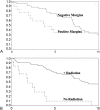Long-term outcome of esthesioneuroblastoma: hyams grade predicts patient survival
- PMID: 24083125
- PMCID: PMC3578642
- DOI: 10.1055/s-0032-1321512
Long-term outcome of esthesioneuroblastoma: hyams grade predicts patient survival
Abstract
Object Esthesioneuroblastoma (ENB) is a rare malignant neuroendocrine tumor originating from the olfactory neuroepithelium in the cribriform plate. Controversy still exists regarding the role of pathologic grading (Hyams grade) in prognostication. This study was undertaken to describe our experience with ENB and assess the role of pathologic grading in patient outcome. Methods This was a retrospective, single-institution experience, including 109 patients with ENB treated at our institution from 1962 to 2009. Multivariate analysis was performed utilizing Cox regression analysis models utilizing age, gender, modified Kadish stage, and Hyams grade. Results Mean age was 49 ± 16 (median 50) years at presentation (range 12 to 90 years). Median follow up was 5.1 years. All-cause mortality was significantly influenced by Hyams grading in univariate (p = 0.04) and multivariate (p = 0.02) analysis, in addition to proven prognostic factors, Kadish staging, lymph node metastasis, and age. Median survival was 9.8 years compared with 6.9 years with low (grade 1 to 2) versus high (grade 3 to 4) Hyams grade. Median overall survival was 7.2 ± 0.7 years. Conclusion ENB has a variable outcome, which is primarily prognosticated by the extent of involvement at presentation (Kadish stage and lymph node metastasis) and higher Hyams pathologic grade.
Keywords: Hyams grade; esthesioneuroblastoma; olfactory neuroblastoma; outcome; surgical treatment.
Conflict of interest statement
Figures






References
-
- Theilgaard S A, Buchwald C, Ingeholm P, Kornum Larsen S, Eriksen J G, Sand Hansen H. Esthesioneuroblastoma: a Danish demographic study of 40 patients registered between 1978 and 2000. Acta Otolaryngol. 2003;123:433–439. - PubMed
-
- Dulguerov P, Allal A S, Calcaterra T C. Esthesioneuroblastoma: a meta-analysis and review. Lancet Oncol. 2001;2:683–690. - PubMed
-
- Elkon D, Hightower S I, Lim M L, Cantrell R W, Constable W C. Esthesioneuroblastoma. Cancer. 1979;44:1087–1094. - PubMed
-
- Kane A J, Sughrue M E, Rutkowski M J. et al.Posttreatment prognosis of patients with esthesioneuroblastoma. J Neurosurg. 2010;113:340–351. - PubMed
-
- Samant S HE Pfister D Hanna E et al.Preoperative high-dose radiotherapy and conmittant cisplatin chemotherapy followed by surgery for advanced paranasal sinus carcinoma Available at: https://wwwnasbsorg/documents/NASBS_PNS100405_protocolpdf2006
LinkOut - more resources
Full Text Sources

